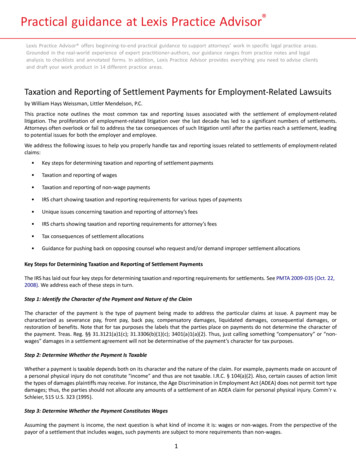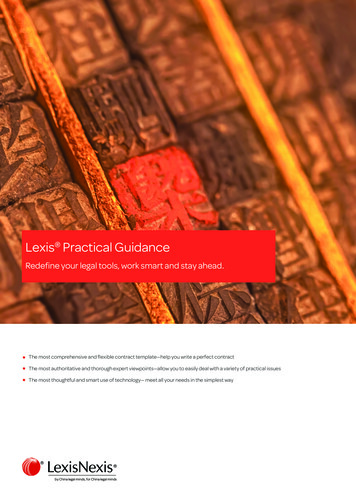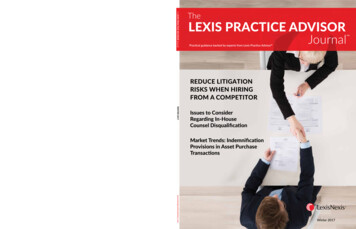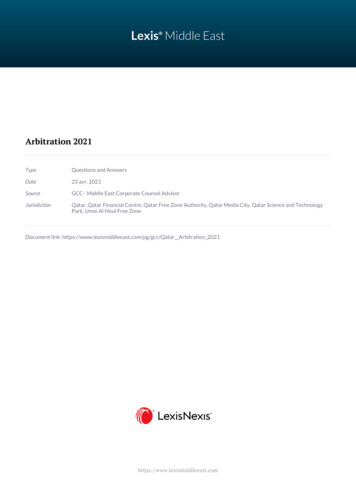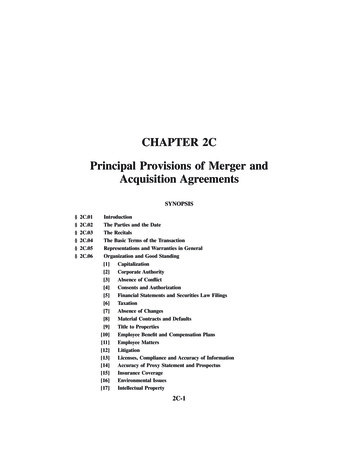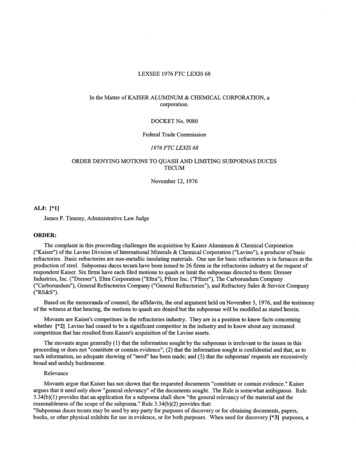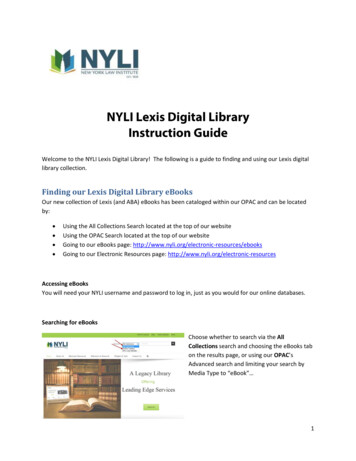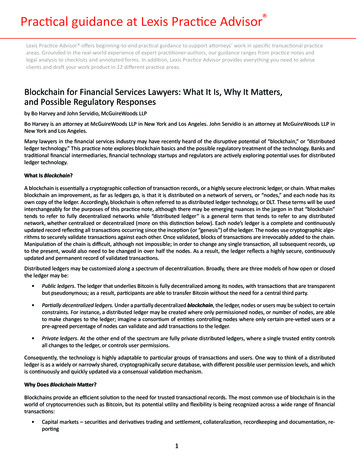
Transcription
Practical guidance at Lexis Practice Advisor Lexis Practice Advisor offers beginning-to-end practical guidance to support attorneys’ work in specific transactional practiceareas. Grounded in the real-world experience of expert practitioner-authors, our guidance ranges from practice notes andlegal analysis to checklists and annotated forms. In addition, Lexis Practice Advisor provides everything you need to adviseclients and draft your work product in 12 different practice areas.Blockchain for Financial Services Lawyers: What It Is, Why It Matters,and Possible Regulatory Responsesby Bo Harvey and John Servidio, McGuireWoods LLPBo Harvey is an attorney at McGuireWoods LLP in New York and Los Angeles. John Servidio is an attorney at McGuireWoods LLP inNew York and Los Angeles.Many lawyers in the financial services industry may have recently heard of the disruptive potential of “blockchain,” or “distributedledger technology.” This practice note explores blockchain basics and the possible regulatory treatment of the technology. Banks andtraditional financial intermediaries, financial technology startups and regulators are actively exploring potential uses for distributedledger technology.What Is Blockchain?A blockchain is essentially a cryptographic collection of transaction records, or a highly secure electronic ledger, or chain. What makesblockchain an improvement, as far as ledgers go, is that it is distributed on a network of servers, or “nodes,” and each node has itsown copy of the ledger. Accordingly, blockchain is often referred to as distributed ledger technology, or DLT. These terms will be usedinterchangeably for the purposes of this practice note, although there may be emerging nuances in the jargon in that “blockchain”tends to refer to fully decentralized networks while “distributed ledger” is a general term that tends to refer to any distributednetwork, whether centralized or decentralized (more on this distinction below). Each node’s ledger is a complete and continuouslyupdated record reflecting all transactions occurring since the inception (or “genesis”) of the ledger. The nodes use cryptographic algorithms to securely validate transactions against each other. Once validated, blocks of transactions are irrevocably added to the chain.Manipulation of the chain is difficult, although not impossible; in order to change any single transaction, all subsequent records, upto the present, would also need to be changed in over half the nodes. As a result, the ledger reflects a highly secure, continuouslyupdated and permanent record of validated transactions.Distributed ledgers may be customized along a spectrum of decentralization. Broadly, there are three models of how open or closedthe ledger may be: Public ledgers. The ledger that underlies Bitcoin is fully decentralized among its nodes, with transactions that are transparentbut pseudonymous; as a result, participants are able to transfer Bitcoin without the need for a central third party. Partially decentralized ledgers. Under a partially decentralized blockchain, the ledger, nodes or users may be subject to certainconstraints. For instance, a distributed ledger may be created where only permissioned nodes, or number of nodes, are ableto make changes to the ledger; imagine a consortium of entities controlling nodes where only certain pre-vetted users or apre-agreed percentage of nodes can validate and add transactions to the ledger. Private ledgers. At the other end of the spectrum are fully private distributed ledgers, where a single trusted entity controlsall changes to the ledger, or controls user permissions.Consequently, the technology is highly adaptable to particular groups of transactions and users. One way to think of a distributedledger is as a widely or narrowly shared, cryptographically secure database, with different possible user permission levels, and whichis continuously and quickly updated via a consensual validation mechanism.Why Does Blockchain Matter?Blockchains provide an efficient solution to the need for trusted transactional records. The most common use of blockchain is in theworld of cryptocurrencies such as Bitcoin, but its potential utility and flexibility is being recognized across a wide range of financialtransactions: Capital markets – securities and derivatives trading and settlement, collateralization, recordkeeping and documentation, reporting1
Practical guidance at Lexis Practice Advisor Trade finance – secondary loan trading, supply chain finance, commodities trading Payments – foreign exchange conversion and settlement, fund transfers or remittances, correspondent banking Real estate – recording transactions, escrow and title insurance services, land title registries Identification of persons, assets or documents – medical records, verification of ownership of assets such as precious metalsor luxury goods, notarization and identity verificationThe flexibility, validation process, efficiency and shared nature of distributed ledger technology are driving an array of financial marketplayers to explore its potential uses. Focusing specifically in the area of capital markets, DLT exhibits a number of possible benefits –and existing limitations that will need to be overcome.Potential benefitsTrade processing.Blockchain technology has the potential to speed up the trade process cycle, from execution through clearing and settlement. Tradeexecution could entail verification of ownership of the asset and the associated payment funds on separate ledgers, thereby increasing transparency between the buyer and seller as to the other’s ability to perform. Upon validation of an executed trade, clearingand settlement could immediately follow. The number of steps in the trade lifecycle could be reduced, or at least compressed, intosingle “straight through processing.” This phrase will be familiar to derivatives lawyers because, since the financial, crisis the U.S.Commodity Futures Trading Commission (CFTC) has made “straight through processing” a regulatory objective for cleared swaps thatare traded on swap execution facilities (SEFs). Distributed ledger technology has the potential to make straight through processingalmost instantaneous, and to make it a feature not just of SEFs but also other trading platforms. For instance, in the United States,equities, corporate and municipal bonds currently settle on a three-day settlement cycle (T 3). In response to regulatory objectivesof decreasing settlement time, the Depository Trust & Clearing Corporation (DTCC) formed an industry group in order to facilitatethe move to shorten the settlement cycle to T 2 for these products. The settlement of syndicated loans takes even longer, up to twoto three weeks. Blockchain has the potential to compress settlement and trade dates into a single date. In this respect, the risk ofsettlement failure is reduced, or caught almost immediately, so that buyers and sellers can address these failures in a timely manner.As a result, the potential for a build-up of negative knock-on effects is limited. Further, by automating many of the processes that arerequired to settle transactions, the use of distributed ledgers may decrease costs associated with manual settlement.Recordkeeping and custody.DLT has the potential to facilitate the recordkeeping of ownership of a variety of assets and safekeeping of those assets through theuse of an automated, shared ledger. For instance, once a transaction is confirmed by the parties, the ledger can irreversibly record thisdata, thereby creating a record of the confirmed terms that can be permanently accessed by the parties or a permissioned third partysuch as an administrator or a regulator. Trade or entity identifiers that are either market standard or mandated by regulators, suchas International Securities Identification Numbers (ISINs), Unique Product Identifiers (UPIs) or Global Legal Entity Identifiers (GLEIs),could be permanently included in this data.In addition, validating ownership claims or a chain of custody could be less cumbersome. Multiple custodial layers could, for all practical purposes, become compressed such that the entire line of custody from beneficial owner to central securities depository (CSD)would be viewed on the ledger, possibly on a close to real-time basis. For instance, the ledger data could be used by asset managersand institutional investors to trace where securities are held. For large portfolios of securities, the ledger could be used to pull up acurrent, detailed view of all holdings at any point in time.Risk mitigation procedures and trade reporting.Following the 2008 financial crisis, regulators implemented increased data transparency and reporting requirements, particularlyfor the derivatives market (e.g., mandatory reporting of swaps to a swap data repository). Regulators also imposed risk mitigationrequirements on bilateral over-the-counter derivatives transactions, such as requiring parties to engage in portfolio reconciliation atspecified intervals. Distributed ledgers could be used to automate trade reporting and portfolio reconciliation procedures on a closeto-real time basis, thereby reducing errors or increasing the speed with which errors are discovered and enabling the parties to takequick remedial action.Smart contracts.Smart contracts are programs that would be introduced into and layered on top of a distributed ledger that may be used to generateinstructions from certain contractual terms. For example, smart contracts could be used in simpler securities or derivatives contractsto automate dividend payments, certain corporate actions, interest payments, termination payments upon maturity or close-out andmanage collateral exchanges. Such payments could be contingent on certain specified conditions. External data sources that have2
Practical guidance at Lexis Practice Advisor been pre-agreed between the parties could be incorporated into trade and collateral valuation, and termination payment calculations. Smart contracts would help automate the implementation of simpler contractual terms while highly structured transactionscould still sit outside the blockchain.In the area of collateral management, fully-paid transactions are not collateralized, hence smart contracts may have limited applicability to these trades because no ongoing obligations remain outstanding between the parties after settlement. However, in the worldof derivatives or financed trades, smart contracts could be used to process and exchange collateral more quickly and incorporateexternal reference data into collateral and trade valuation (where the parties have agreed to use external reference data). An efficientprocess for trade valuation and collecting collateral would also, in theory, lead to less lag time between valuation of a trade and theresulting collateral exchange. This has the potential to reduce the systemic risk that arises from discrepancies between valuation andcollateralization.Security and law enforcement.Distributed ledger technology is often portrayed as highly secure based on its distributed nature and use of cryptography and consensus to validate contracts. This remains to be fully tested against sophisticated cyberattacks. However, the built-in redundancy ofdistributed ledgers could reduce the need for recovery plans because records of the ledger are kept across the network in severalplaces simultaneously.A fitting application for the technology could be in the realm of anti-money laundering / anti-terrorism regulations and know-your-customer (KYC) requirements. All transactions are retraceable across the ledger; therefore, regulators, self-regulatory organizations(SROs) and banks could use the ledger to enforce these types of regulations assuming any required privacy safeguards are in place.In short, certain aspects of the financial market could benefit from reduced costs and increased efficiencies of distributed ledgertechnology. One study suggested that use of distributed ledgers could reduce banks’ infrastructure costs by 15-20 billion per year by2022 (Santander InnoVentures, Oliver Wyman and Anthemis Group, The Fintech 2.0 Paper). If so, the cumulative cost savings couldbe significant.Potential limitationsThe benefits of distributed ledgers need not be overstated. The following are challenges to widespread implementation.Technological issues.Blockchains have been tested by market participants on a small, focused scale, but the degree of scale needed to realize the benefitsof blockchain in the securities and derivatives markets is currently untested. It also remains to be seen whether DLT will be interoperable with the internal and external systems that underlie current market infrastructure. Separate ledgers would also need to be ableto interact with each other as well as existing market infrastructure.The security of the blockchain process is not absolute. In a fully distributed ledger, in theory, the transaction validation process couldbe corrupted if a hacker controlled over half of the computers within the network (a “51% attack”) due to the way transactions arevalidated via a consensus mechanism. In a widely dispersed network this would be difficult to do but is not impossible. Private orpartially decentralized ledgers, while free of some of these issues, could be at risk of a focused cyberattack on the central node ornodes that validate transactions.In addition, while the dispersion of a ledger might mitigate the risk of a single point of failure, a shared ledger could create increaseinterconnectedness of market participants, thereby spreading systemic shocks quickly. If a shared ledger formed the basis of coremarket infrastructure, its failure might be similar to other low-risk but high-impact events, such as the failure of a CCP.Settling in fiat currency.In order to achieve full benefits of settling cash trades, both the asset and cash portions of a transaction need to be processed simultaneously – and unless fiat cash currency is recorded on the ledger or the cash leg is translated into “redeemable” fiat currency, theutility of distributed ledgers in cash trade settlement will be limited.Governance, legal recourse and public policy.As distributed ledger technology currently exists, once transactions are validated, they are considered immutable and cannot bemodified, cancelled or rescinded. From a legal perspective, a degree of ex post flexibility gives parties the opportunity to amendtrades, correct bona fide mistakes and enforce equitable remedies in court. Parties may leave contractual terms to future negotiationor to course-of-dealing or course-of-performance standards. Terms that are fact-heavy and highly contextualized, such as whether acustodian acted with gross negligence or a party acted with fraudulent intent, are not currently reducible to smart contract coding.Further, public policy concerns are implicated when externalities are imposed on third parties that never signed the original contract.3
Practical guidance at Lexis Practice Advisor Consequently, the use of distributed ledgers in the securities and derivatives markets will continue to be constrained by the need fortrusted intermediaries and third parties, whether judges, regulators, industry groups or SROs (such as CCPs or exchanges), to provideforums for redress and impose supervisory frameworks.Counterparty risk.As noted above, distributed ledger technology has the potential to reduce settlement risk; some may even say it eliminates the needfor clearing organizations to act as central counterparties (CCPs). While this might be the case for fully-paid transactions where settlement extinguishes the obligations of both parties at once, for financed or derivatives transactions, obligations remain through the lifeof the transaction. Use of blockchains is unable to eliminate counterparty credit risk to the extent there is any gap between paymentand delivery such that there exists ongoing contractual obligations. As a result, there is still a role for CCPs or other intermediariesas credit backstops in the event one party fails before settlement. Even for fully-paid transactions, there is likely to be a need for acentral, trusted entity to manage electronic ledgers in order to make necessary corrections due to non-bona fide transactions (e.g.,addressing “fat-finger” trades, “spoofing” or manifestly erroneous bids and offers). As a result, CCPs such as DTCC (for securities) orChicago Mercantile Exchange (for futures and derivatives), among others, are likely to continue playing a credit intermediation andsupervisory role in trade settlement.Margin finance and netting exposures.Distributed ledgers record transactions sequentially and on a “gross” basis; these are existing constraints on the ability of electronicledgers to account for net, rather than gross, exposures between counterparties, for instance across derivatives liabilities. Further, thepossession of assets is a requirement for transacting on most blockchain systems, although certain players are working to remove thisimpediment which limits the ability of the ledger to record transactions that are financed or where outright ownership is not presentas it is in fully-paid transactions.Regulatory Responses to BlockchainHow will existing financial regulations impact blockchain? Will regulators need to apply new regulatory principles governing blockchain? Will regulators mandate the use of blockchain for certain processes? These are all questions the industry, and regulators, areexploring. A sample of recent pronouncements from regulators, SROs and policymakers around the world include: In June 2016, the European Securities and Markets Authority (ESMA) issued a discussion paper and called for public feedbackon the potential uses and regulatory framework for DLT in the securities and derivatives markets. In June 2016, the Bank of Canada confirmed that it is involved in a proof-of-concept project testing the use of distributed ledgers for interbank payments. R3 CEV, a start-up backed by a consortium of global banks, was also involved in the test. In May 2016, Delaware Governor Jack Markell announced the “Delaware Blockchain Initiative” embracing the use of distributed ledgers and smart contracts, including exploration of whether clarifications to Delaware corporate law are needed tofacilitate the use of DLT for the issuance of equity securities by Delaware corporations. In March 2016, the U.S. Office of the Comptroller of the Currency released a white paper promoting a “responsible innovation”approach for banks and non-bank financial technology companies experimenting with DLT and advanced payment systems. In March 2016, Commissioner J. Christopher Giancarlo of the CFTC gave a speech introducing a “do no harm” regulatory thesisto the development and use of distributed ledgers. In September 2014, the Bank of England issued a white paper demonstrating the potential impact of DLT in payment systems. Since 2014, several major exchanges and clearinghouses worldwide have announced, or have been reported as being involvedin, initiatives exploring blockchain applications, from trading platforms to recordkeeping and settlement functions. This includes, among others, the London Stock Exchange, CME Group, Australian Stock Exchange, Nasdaq, DTCC and Euroclear.The rules eventually adopted by regulators will depend on how crucial market functions will use blockchain technology and the relevant bodies of law for each application. A few examples might include the following:Securities issuance – in June 2015, Overstock.com became the first public company to issue a private security using blockchaintechnology. In December 2015, the Securities and Exchange Commission (SEC) declared effective Overstock’s S-3 filing for the publicissuance of “digital” shares on a distributed ledger. Overstock’s S-3 addresses a number of additional risk factors that are implicatedby the company’s use of DLT, illustrating that while it may be a unique, novel medium for securities offerings, lawyers can expecttraditional securities legislation, rules and case law to continue to apply to distributed ledger technology. Further, applicable statecorporate law will apply as it may be modified for the particularities of distributed ledgers – such as any changes to corporate law thatDelaware might implement as a consequence of the state’s Blockchain Initiative.4
Practical guidance at Lexis Practice Advisor Securities clearing – if distributed ledgers are used to revamp the role of clearinghouses, then the applicable regulatoryregime will depend on which regulatory agency is the primary supervisor of the clearing organization. For instance, Section3(a)(34)(B) of the Securities Exchange Act establishes the appropriate regulatory agency for different clearing agents, or ifthe clearing agent is not supervised by a banking regulator, the SEC. This creates the possibility for fragmentation if differentregulators move at different speeds when it comes to establishing a regulatory framework or establish conflicting frameworks. Securities settlement – SEC Rule 15c6-1(a) establishes T 3 as the standard settlement cycle for certain securities. This illustrates that existing rules may need to be reviewed and updated if widespread use of DLT causes market changes, such as acompression of settlement cycles. Securities trading / recordkeeping – under the consolidated audit trail (CAT) initiative, the SEC Rule 613 creates a comprehensive trail that would track all activity in exchange-listed equities and options throughout U.S. national securities markets, downto identification of every order, cancellation, modification and trade execution. While blockchain use for a massive industrywide project like this is premature, any future application of blockchain to CAT would be subject to Rule 613 requirements andthe applicable rules of any supervisory SROs. Derivatives trading / clearing / reporting – after the passage of the Dodd-Frank Wall Street Reform and Consumer ProtectionAct (Dodd-Frank) the CFTC unrolled several rules mandating clearing, reporting and exchange trading of bilateral swaps andother derivatives. Any use of distributed ledger technology to facilitate compliance with these mandates would be subject toDodd-Frank, the Commodity Exchange Act and related CFTC rules. Derivatives collateralization – Dodd-Frank also required that uncleared derivatives be collateralized in accordance with certainstandards. Any use of smart contracts to effect collateralization of swaps would need to comply with related rules promulgated by the CFTC and banking regulators such as the Office of the Comptroller of the Currency, the Federal Reserve Board ofGovernors and the Federal Deposit Insurance Corporation.While not by any means comprehensive, these examples illustrate that any application of distributed ledgers might trigger differentregulatory regimes depending on the nature of use. The technology’s innovative potential is being embraced as a way to improveefficiencies, lower transactional costs and manage and reduce risk. If widely adopted by the financial industry, distributed ledgertechnology would touch several different areas of law governing capital markets.This excerpt from Lexis Practice Advisor , a comprehensive practical guidance resource providing insight from leading practitioners, is reproduced with thepermission of LexisNexis. Lexis Practice Advisor includes coverage of the topics critical to attorneys who handle transactional matters. For more informationor to sign up for a free trial visit www.lexisnexis.com/practice-advisor. Reproduction of this material, in any form, is specifically prohibited without writtenconsent from LexisNexis.Learn more at: lexisnexis.com/practice-advisorLexisNexis, Lexis Practice Advisor and the Knowledge Burst logo are registered trademarks of Reed Elsevier Properties Inc., used under license. 2016 LexisNexis. All rights reserved.5
legal analysis to checklists and annotated forms. In addition, Lexis Practice Advisor provides everything you need to advise clients and draft your work product in 12 different practice areas. 1 Blockchain for Financial Services Lawyers: What It Is, Why It Matters, and Possible Regulatory Responses by Bo Harvey and John Servidio, McGuireWoods LLP

